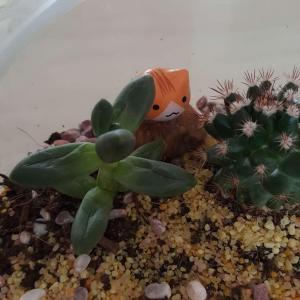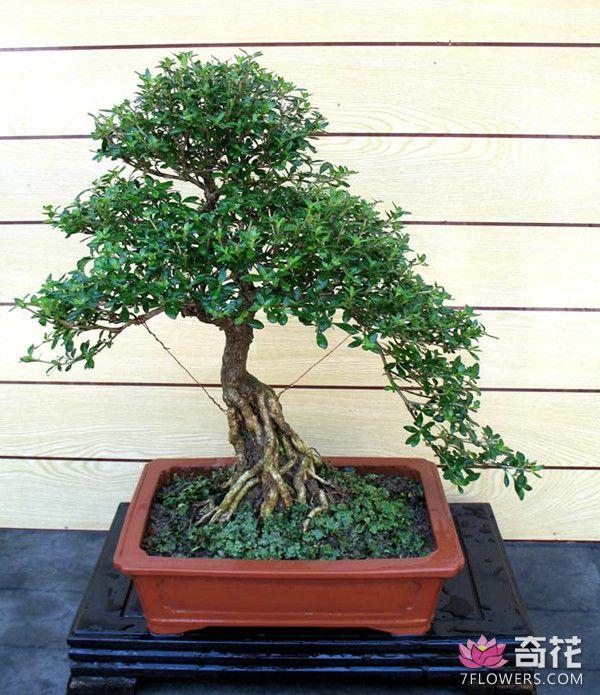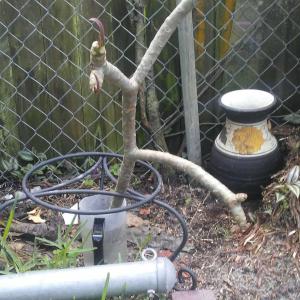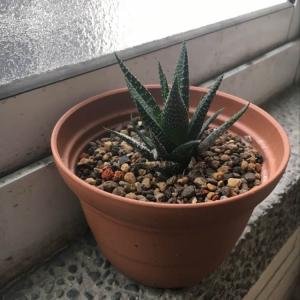文章
权问薇
2017年07月23日


1缺水
表现:叶梢、叶边缘发干,并且枯黄,新生的嫩叶正常,但是下部的老叶却枯黄脱落。
解决办法:立刻浇水,一次性浇透,一定要看见水从下面的孔里流出来。
2水太多
表现:叶子整体黯淡无光,色泽偏黄,而且新长出来的叶子,顶稍部分梢萎缩。
解决办法:停止浇水,用铲子或者是钩子松一下土,同时放到散射光充足,并且通风良好的地方,好让水分尽快蒸发。
3光照问题
表现:无论新叶还是老叶都整体偏黄,如果在叶子上发现了灼伤的痕迹,说明光照非常强烈。
解决办法:摆放在光线明亮的客厅,散射光充足,而且不用接受太阳直射!
4肥太多
表现:叶片肥厚,但是黯淡,且下部的老叶片开始泛黄脱落。
解决办法:刚施肥就发现施肥过多,可用清水冲洗盆土,让多余肥料溶解在水中,然后顺着水流从下面的小孔流出来。
如果施肥很久之后才发现,那就只能换土了。
以后施肥的时候要注意薄肥勤施哦~
5肥太少
表现:绿萝的叶子显示颜色变淡,变成淡绿色,而后缓缓地变成黄色,一般从根部的叶子开始,然后慢慢蔓延到顶部叶片。
解决办法:平时可以给绿萝浇已经充分腐熟的淘米水、豆饼水等等,淘米水按照1:4的比例进行浇花,1周1~2次即可;豆饼水按照1:50的比例兑水稀释,1周1次即可。
绿萝换盆时埋进去一些缓释肥,也可以1个月左右埋进去一小把缓释肥,但是不能接触到绿萝的根部。
6烂根
表现:叶子发黄、倒伏、萎蔫,比较严重的甚至能够看到已经腐烂的茎干。
解决办法:如果烂根情况不是很严重,将根部腐烂的地方切掉,然后消毒杀菌后,重新上盆即可,注意,盆土要更换成新的哦
烂根的特别厉害,选取比较健康的枝条,消毒后重新扦插即可,或者是水插。
1
2
文章
我家狗狗会尖叫
2017年07月23日

萱草以分株繁殖为主,春、秋季均可进行,但以春季为主。分株后夏季就可以开花。每年2〜3月挖取地下宿根,剪去枯根及过多的须根,3〜5芽分栽一盆。露地栽植的株行距0.5-0.8m,每穴种植4〜5株。穴内先放堆肥盖上细土,再将植株栽于穴内。种植不宜太深,土壅至根颈处即可。种植时注意不要损坏叶芽,栽后施足水分。人冬前施腐熟堆肥一次,生长期按一般肥水管理进行。一般3~5年分株一次。盆栽结合分株每年换盆一次。

繁殖方法
繁殖方法以分株繁殖为主,育种时用播种繁殖。分株繁殖于叶枯萎后或早春萌发前进行,将根株掘起剪去枯根及过多的须根,分株即可。一次分株后可4~5年后再分株,分株苗当年即可开花。种子繁殖宜秋播,一般播后4星期左右出苗。夏秋种子采下后如立即播种,20天左右出苗。播种苗培育2年后开花。
栽培管理
栽培管理简单粗放,株行距0.5×1米左右,每穴栽3~5株。栽前施足基肥。由于萱草适应性强,几乎随处可种,任其生长,株丛可年年不断扩大,但在庭园配植时应按株高和花色进行搭配,以提高观赏效果。
栽培要点
喜温暖湿润环境。土壤以稍带粘性较好。可在田坎、水沟边、住宅旁等处栽培。分株繁殖。10~11月地上部枯萎后或春季植株未萌芽前,挖起全株,每2、3等分为一丛。
栽前,按行、株距各40cm开穴,穴深17~20cm,每穴栽一丛,根要向四面平铺,盖土压紧。浇水或灌浇人畜粪水。自第二年起,每年中耕除草和追肥3次,第一次在3月出苗时,第二次在6月开花前,第三次在10月倒苗后,每次中耕除草后,施用人畜粪水。
病虫害防治
萱草常见的病害有叶斑病、叶枯病、锈病、炭疽病和茎枯病等:虫害主要有红蜘蛛、蚜虫、蓟马、潜叶蝇等。
防治病虫害:首先要搞好农业防治,在黄花菜采摘完后,地上部随即枯死,应及时割蔸并运离黄花菜地外,以减少菌源、虫源;搞好黄花菜的追肥、冬培工作,以增强抗病能力;适时更新复壮老蔸;选用抗病品种等。适时用药防治,病害可用75%的百菌清800倍液喷雾防治,虫害可用艾美乐3000倍喷雾防治。
萱草也可播种繁殖,种子随采随播,次春出芽,如在下年春播,当年不能发芽出苗。萱草易遭蚜虫为害,喷40%氧化乐果1500倍液防治。

繁殖方法
繁殖方法以分株繁殖为主,育种时用播种繁殖。分株繁殖于叶枯萎后或早春萌发前进行,将根株掘起剪去枯根及过多的须根,分株即可。一次分株后可4~5年后再分株,分株苗当年即可开花。种子繁殖宜秋播,一般播后4星期左右出苗。夏秋种子采下后如立即播种,20天左右出苗。播种苗培育2年后开花。
栽培管理
栽培管理简单粗放,株行距0.5×1米左右,每穴栽3~5株。栽前施足基肥。由于萱草适应性强,几乎随处可种,任其生长,株丛可年年不断扩大,但在庭园配植时应按株高和花色进行搭配,以提高观赏效果。
栽培要点
喜温暖湿润环境。土壤以稍带粘性较好。可在田坎、水沟边、住宅旁等处栽培。分株繁殖。10~11月地上部枯萎后或春季植株未萌芽前,挖起全株,每2、3等分为一丛。
栽前,按行、株距各40cm开穴,穴深17~20cm,每穴栽一丛,根要向四面平铺,盖土压紧。浇水或灌浇人畜粪水。自第二年起,每年中耕除草和追肥3次,第一次在3月出苗时,第二次在6月开花前,第三次在10月倒苗后,每次中耕除草后,施用人畜粪水。
病虫害防治
萱草常见的病害有叶斑病、叶枯病、锈病、炭疽病和茎枯病等:虫害主要有红蜘蛛、蚜虫、蓟马、潜叶蝇等。
防治病虫害:首先要搞好农业防治,在黄花菜采摘完后,地上部随即枯死,应及时割蔸并运离黄花菜地外,以减少菌源、虫源;搞好黄花菜的追肥、冬培工作,以增强抗病能力;适时更新复壮老蔸;选用抗病品种等。适时用药防治,病害可用75%的百菌清800倍液喷雾防治,虫害可用艾美乐3000倍喷雾防治。
萱草也可播种繁殖,种子随采随播,次春出芽,如在下年春播,当年不能发芽出苗。萱草易遭蚜虫为害,喷40%氧化乐果1500倍液防治。
0
1
文章
Dummer. ゛☀
2017年07月22日

Family - Scrophulariaceae
Stems - To +1m tall, erect, herbaceous but stout, terete near the base, angled in the apical 1/2, scaberulous, puberulent, much-branched, from a big taproot, mostly green.

Leaves - Opposite, linear, entire, antrorse strigose, acute, to +3cm long, 1-1.5mm broad, slightly folded, with well developed axillary fascicles. Fascicles as long or longer than the subtending leaf.

Inflorescence - Axillary racemes in the upper 2/3 of the stem. Racemes very bracteate and the inflorescence appearing as just axillary flowers. Flowers single from each leaf (bract) axil, 1-2 per node, opposite. Pedicels 3-5mm long, shorter than or equaling the calyx, glabrous, ascending. Axis of the inflorescence angled, puberulent.
Flowers - Corolla pink, to +2cm long, 5-lobed. Corolla tube densely antrorse pubescent externally, mostly glabrous internally, contracted in the basal 5mm (the portion surrounded by the calyx). Corolla tube with pink spots and two yellow stripes internally (ventrally). Corolla lobes rounded, with pilose margins, to +1cm broad, 1cm long, spreading, the upper two pilose-bearded at the base internally. Stamens 4, didynamous, mostly included. Filaments pale pink to whitish, pink pilose, to +1cm long, adnate at the apex of the contracted portion of the corolla tube. Anthers whitish, pilose dorsally, +/-3mm long, 1.5mm broad, with two acute basal lobes. Style 1, exserted beyond the corolla and from between the stamens, pale purple basally, whitish at the apex, mostly glabrous and terete, flattened and puberulent on the margins in the apical 1/3 (the stigma). Ovary superior, green, glabrous, ovoid, to 2mm long in flower, 2-locular, with many ovules. Placentation axile. Calyx campanulate, green, glabrous, 5mm long in flower, 5-lobed. Lobes 1-1.6mm long, triangular-attenuate with a slight keel that somewhat ribs the calyx tube in the apical 1/2. Most dorsal calyx lobe slightly larger than the others.

Flowering - August - October.
Habitat - Prairies, sandy open ground, thickets, woodland edges, fallow fields.
Origin - Native to U.S.
Other info. - This striking species can be found mainly in southwestern Missouri. The plant can be identified by its big flowers (which have yellow stripes and pink spots internally), and its linear leaves which have well developed axillary fascicles. The plant is very common in states to the south and east and extends up the east coast to Maryland. This species reaches its inland northern limit in Missouri.
A synonym for this species is Gerardia fasciculata Ell.
Stems - To +1m tall, erect, herbaceous but stout, terete near the base, angled in the apical 1/2, scaberulous, puberulent, much-branched, from a big taproot, mostly green.

Leaves - Opposite, linear, entire, antrorse strigose, acute, to +3cm long, 1-1.5mm broad, slightly folded, with well developed axillary fascicles. Fascicles as long or longer than the subtending leaf.

Inflorescence - Axillary racemes in the upper 2/3 of the stem. Racemes very bracteate and the inflorescence appearing as just axillary flowers. Flowers single from each leaf (bract) axil, 1-2 per node, opposite. Pedicels 3-5mm long, shorter than or equaling the calyx, glabrous, ascending. Axis of the inflorescence angled, puberulent.
Flowers - Corolla pink, to +2cm long, 5-lobed. Corolla tube densely antrorse pubescent externally, mostly glabrous internally, contracted in the basal 5mm (the portion surrounded by the calyx). Corolla tube with pink spots and two yellow stripes internally (ventrally). Corolla lobes rounded, with pilose margins, to +1cm broad, 1cm long, spreading, the upper two pilose-bearded at the base internally. Stamens 4, didynamous, mostly included. Filaments pale pink to whitish, pink pilose, to +1cm long, adnate at the apex of the contracted portion of the corolla tube. Anthers whitish, pilose dorsally, +/-3mm long, 1.5mm broad, with two acute basal lobes. Style 1, exserted beyond the corolla and from between the stamens, pale purple basally, whitish at the apex, mostly glabrous and terete, flattened and puberulent on the margins in the apical 1/3 (the stigma). Ovary superior, green, glabrous, ovoid, to 2mm long in flower, 2-locular, with many ovules. Placentation axile. Calyx campanulate, green, glabrous, 5mm long in flower, 5-lobed. Lobes 1-1.6mm long, triangular-attenuate with a slight keel that somewhat ribs the calyx tube in the apical 1/2. Most dorsal calyx lobe slightly larger than the others.

Flowering - August - October.
Habitat - Prairies, sandy open ground, thickets, woodland edges, fallow fields.
Origin - Native to U.S.
Other info. - This striking species can be found mainly in southwestern Missouri. The plant can be identified by its big flowers (which have yellow stripes and pink spots internally), and its linear leaves which have well developed axillary fascicles. The plant is very common in states to the south and east and extends up the east coast to Maryland. This species reaches its inland northern limit in Missouri.
A synonym for this species is Gerardia fasciculata Ell.
0
0
求助
AzureAngel
2017年07月21日

why are the leaves wrinkilng up? I've been watering for 2 days straight now. Repotted it and noticed very little roots. How come




2
0
Abby Gill:You are watering your succulents too much, only water it when the soil is completely dry or once a week.
sarajordan2993:first of all , wayyyyy too much water . water when the soil is dry down to about an inch to an inch and a half deep . until then , do. not. water. i water mine with a spray bottle at least once a week . that way the amount of water i give them is 100% in my control. also , if they are put into direct sunlight , after being inside for awhile ... they will get a sunburn (yes , succulents can get sunburns) & that will cause the leaves to start getting shriveled.
shirly mei:If the leaf are soggy, it's probably too much watering. You have to water the succulent only when you see the soil completely dry. wait till it's dry and water it a lot till you see the water coming out of the drainage hole.
文章
蒋欣
2017年07月19日

盆景制作
#六月雪 喜半阴,怕积水,畏烈日,抗性较强,盆栽必须选用松软山土,应放置在向阳处,不能久放室内。在生长期需施1~2次肥料,盆土宜偏干些为好,肥水过多过浓会引起枝叶徒长。具有叶细、枝密、干粗、根露的特点,故作为盆景的佳材之一。六月雪的枝干软而韧,能经受蟠扎,分为直乾式、虬曲式、悬崖式等。如盆体高,可育成悬崖式。悬崖式因倾斜度的大小不同又分为半悬、全悬、小悬。所谓半悬,即树乾基本上横出盆口。全悬的树干得垂下盆口45度。小悬的树乾一般则垂下30度至40度左右。也可自然式,略加修整。

繁殖以扦插为主,也可用压条、分株、扦插等法,一般是初春季节用硬枝,但在梅雨季节用缴枝、老枝均可,在制作小型或微型盆景时,为促使其尽快成型,常在6-7月梅雨季节,取姿态优美,有大树型的多年生枝,将下切口剪成马蹄形,插入经石或砂中,罩膜保温,注意喷水,约40天可生根,此时加以移植,稍加绑扎修剪即可成型。由於此草山野各地容易觅得,所以有些养花者常从林问直接挖取回来上盆。
六月雪适应性强,栽培养护较简单,但因其畏烈日暴晒,生长期宜放置在半阴湿润的树阴等处,否则会因光照太强而影响生长,不利观赏。此草虽较喜肥,但若施肥过多,使发枝过旺,易引起新枝徒长,一般只在入冬前和花後各施一次腐熟的饼肥水。它有一定的耐旱能力,却不耐水湿,浇水要掌握问於问湿、不於不浇的原则,雨季要防盆中积水,若在多雨天气,应将盆侧放;夏季高温乾燥时节,早晚要向叶面喷水降温,增加空气湿度,以利其生长开花。
因六月雪的萌发力特强,主干及根部都会萌发出许多新枝,要及时剥除多余的新技,以免消耗养分,扰乱树形正常发育。对花后萌发的突出树冠外的枝条,也要加以修剪,否则影响观赏。
六月雪在冬季若保持5℃以上,则枝叶葱绿常青,但土壤不能大干,要使其稍微湿润些。

盆景制作方法
桩材来源
春季3月份进行分株繁殖,4-10月进行扦插(枝插或根插)繁殖,若采用保护地(苗床)繁殖,可在11月至翌年1月进行扦插。在我国东南部和中部各省区,还可到野外挖掘野生树桩培育加工。
加工造型
可采用“蓄木截干法”加工,也可采用“剪扎结合法”加工造型。蟠扎常在冬季半落叶后至春季萌芽前进行,主干和主枝用金属丝蟠扎,小枝经精细修剪成型。
移栽上盆
宜在2-3月进行移栽上盆,也可在梅雨季节及深秋进行。选用较浅的圆形、方形或椭圆形的紫砂盆或釉盆,盆色宜略深一些,与花色形成对比。盆土要求为富含有机质、疏松肥沃、排水透气性能良好的沙壤土,可用腐殖土、松针土、草炭掺进40%的沙或稻壳灰混合配制。

水肥管理
生长季节应经常浇水,保持盆土湿润,不宜长时间过干或过湿,切忌盆内积水或盆土失水,夏季每天往叶面喷水1-2次;冬季应适当减少浇水次数,保持盆土湿润稍偏干即可。每年4-5月浇施2-3次0.5%浓度的磷钾肥液;在腊冬追施1-2次稀薄的有机肥液,其它季节不宜施肥。忌施浓肥。
光温要求
生长期宜放在阳光充足,温暖湿润,通风良好的地方养护,夏季初秋应遮阳50%-70%,忌暴晒,冬季在南方可室外越冬,北方应移入室内,保持室温5-12℃为好。
翻盆与修剪
隔1-2年翻盆1次,于春季2-3月或深秋期间进行,剔去全部旧土,适当修剪根部。可结合翻盆进行提根,使其形成悬根,提高观赏价值。每年冬季半落叶后至翌春萌芽前,进行1次整形修剪,剪短长枝、徒长枝,疏去过密的细弱枝,剪去病虫枝以及其它影响观赏的杂乱枝;生长期适时进行摘心、抹芽、除分枝等,使其保持优美的造型。剪下的健康枝条可用于扦插繁殖。
病虫害防治
六月雪盆景的病虫害较少,偶有蚜虫和蜗牛发生。蚜虫可用风油精稀释500-600倍液喷杀;蜗牛可用58%风雷激乳油1500倍液喷杀。有时会发生根腐病,在初发病时可用12%松脂酸铜乳油600-1000倍液,或50%根腐灵800倍液灌根和叶面喷雾防治,每隔3-5天喷(灌)1次,连续喷(灌)3-4次。
#六月雪 喜半阴,怕积水,畏烈日,抗性较强,盆栽必须选用松软山土,应放置在向阳处,不能久放室内。在生长期需施1~2次肥料,盆土宜偏干些为好,肥水过多过浓会引起枝叶徒长。具有叶细、枝密、干粗、根露的特点,故作为盆景的佳材之一。六月雪的枝干软而韧,能经受蟠扎,分为直乾式、虬曲式、悬崖式等。如盆体高,可育成悬崖式。悬崖式因倾斜度的大小不同又分为半悬、全悬、小悬。所谓半悬,即树乾基本上横出盆口。全悬的树干得垂下盆口45度。小悬的树乾一般则垂下30度至40度左右。也可自然式,略加修整。

繁殖以扦插为主,也可用压条、分株、扦插等法,一般是初春季节用硬枝,但在梅雨季节用缴枝、老枝均可,在制作小型或微型盆景时,为促使其尽快成型,常在6-7月梅雨季节,取姿态优美,有大树型的多年生枝,将下切口剪成马蹄形,插入经石或砂中,罩膜保温,注意喷水,约40天可生根,此时加以移植,稍加绑扎修剪即可成型。由於此草山野各地容易觅得,所以有些养花者常从林问直接挖取回来上盆。
六月雪适应性强,栽培养护较简单,但因其畏烈日暴晒,生长期宜放置在半阴湿润的树阴等处,否则会因光照太强而影响生长,不利观赏。此草虽较喜肥,但若施肥过多,使发枝过旺,易引起新枝徒长,一般只在入冬前和花後各施一次腐熟的饼肥水。它有一定的耐旱能力,却不耐水湿,浇水要掌握问於问湿、不於不浇的原则,雨季要防盆中积水,若在多雨天气,应将盆侧放;夏季高温乾燥时节,早晚要向叶面喷水降温,增加空气湿度,以利其生长开花。
因六月雪的萌发力特强,主干及根部都会萌发出许多新枝,要及时剥除多余的新技,以免消耗养分,扰乱树形正常发育。对花后萌发的突出树冠外的枝条,也要加以修剪,否则影响观赏。
六月雪在冬季若保持5℃以上,则枝叶葱绿常青,但土壤不能大干,要使其稍微湿润些。

盆景制作方法
桩材来源
春季3月份进行分株繁殖,4-10月进行扦插(枝插或根插)繁殖,若采用保护地(苗床)繁殖,可在11月至翌年1月进行扦插。在我国东南部和中部各省区,还可到野外挖掘野生树桩培育加工。
加工造型
可采用“蓄木截干法”加工,也可采用“剪扎结合法”加工造型。蟠扎常在冬季半落叶后至春季萌芽前进行,主干和主枝用金属丝蟠扎,小枝经精细修剪成型。
移栽上盆
宜在2-3月进行移栽上盆,也可在梅雨季节及深秋进行。选用较浅的圆形、方形或椭圆形的紫砂盆或釉盆,盆色宜略深一些,与花色形成对比。盆土要求为富含有机质、疏松肥沃、排水透气性能良好的沙壤土,可用腐殖土、松针土、草炭掺进40%的沙或稻壳灰混合配制。

水肥管理
生长季节应经常浇水,保持盆土湿润,不宜长时间过干或过湿,切忌盆内积水或盆土失水,夏季每天往叶面喷水1-2次;冬季应适当减少浇水次数,保持盆土湿润稍偏干即可。每年4-5月浇施2-3次0.5%浓度的磷钾肥液;在腊冬追施1-2次稀薄的有机肥液,其它季节不宜施肥。忌施浓肥。
光温要求
生长期宜放在阳光充足,温暖湿润,通风良好的地方养护,夏季初秋应遮阳50%-70%,忌暴晒,冬季在南方可室外越冬,北方应移入室内,保持室温5-12℃为好。
翻盆与修剪
隔1-2年翻盆1次,于春季2-3月或深秋期间进行,剔去全部旧土,适当修剪根部。可结合翻盆进行提根,使其形成悬根,提高观赏价值。每年冬季半落叶后至翌春萌芽前,进行1次整形修剪,剪短长枝、徒长枝,疏去过密的细弱枝,剪去病虫枝以及其它影响观赏的杂乱枝;生长期适时进行摘心、抹芽、除分枝等,使其保持优美的造型。剪下的健康枝条可用于扦插繁殖。
病虫害防治
六月雪盆景的病虫害较少,偶有蚜虫和蜗牛发生。蚜虫可用风油精稀释500-600倍液喷杀;蜗牛可用58%风雷激乳油1500倍液喷杀。有时会发生根腐病,在初发病时可用12%松脂酸铜乳油600-1000倍液,或50%根腐灵800倍液灌根和叶面喷雾防治,每隔3-5天喷(灌)1次,连续喷(灌)3-4次。
0
1
文章
Miss Chen
2017年07月19日


Nombre científico o latino: Caragana arborescens
Nombre común o vulgar: Caragana, Acacia de Rusia, Arbusto del guisante.
Familia: Fabaceae.
Origen: Siberia.
Arbustos de hoja caduca.
Altura: 2-5 metros.
Forma redondeada.
Posee ramas espinosas.
Hojas: paripinnadas con 8/12 folíolos y con estipulas muy cortas.
Floración muy abundante de color amarillo vivo.
Floración a final de primavera.

Uso como arbusto o árbol pequeño de macizos.
Leguminosa de clima continental.
Luz: sol, semisombra.
Suelo: cualquiera, incluso calizo, pero bien drenado.
Multiplicación: por semillas.
0
0
文章
Dummer. ゛☀
2017年07月19日

Family - Asteraceae
Stems - Herbaceous, erect, to +60cm tall, from a thick caudex, simple below but branching in the apical 1/2 (inflorescence), terete, 2-4mm n diameter, typically multiple from the base, glabrescent at the base, scabrous and pubescent in the apical 1/2, with many small antrorse multicellular (use a lens to see) trichomes, light green and often with darker green vertical striations.

Leaves - Alternate, petiolate. Lowest leaves long petiolate. Petioles narrowly winged by decurrent leaf tissue, mostly glabrous. Blades linear-elliptic, with a few coarse but shallow teeth or entire, somewhat scabrous from the thickened bases of the hairs, antrorse strigillose on the margins. Leaf and petiole combined to +15cm long, 1cm broad. Cauline leaves reduced upward, becoming scale-like in the inflorescence. All leaves with a cartilaginous margin approximately .1mm broad. Light from underneath to see this.
Inflorescence - Corymbose arrangement of flower heads. Peduncles bracteate with reduced leaves, often with some arachnoid pubescence.
Involucre -To +/-6mm long and broad, cupulate to cylindric. Phyllaries imbricate, appressed, oblong, acute at the apex, to 5mm long, 1.4mm broad, glabrous externally, with a few appressed hairs or glabrous internally. Margins entire or minutely ciliolate, mostly scarious in the middle portion, with darker green apices, pale at the base.

Ray flowers - +/-12 per flower head, pistillate, fertile. Ligules glabrous, white, 5-7mm long, 2-3mm broad. Corolla tube white, +/-2mm long, glabrous. Pistil glabrous, becoming purple towards the apex, to 2.7mm long, bifurcate at the apex for +/-.4mm. Achene to +1mm long in flower, white, glabrous. Pappus of numerous capillary bristles. Bristles white, barbellate, -5mm long.
Disk flowers - Disk 6mm broad, with many flowers. Corolla 4mm long, pale yellow in the apical 1/2, greenish basally, glabrous externally and internally, 5-lobed. Lobes acute, .5mm long, erect to slightly spreading. Stamens 5, adnate at the base of the corolla tube. Filaments translucent, 2-2.2mm long, glabrous, compressed. Anthers connate around the style, 1.5-1.9mm long, yellow, drying to brown. Style to 4mm long, greenish-translucent, glabrous, bifurcate in the apical 1mm. The stigmas erect. Achenes glabrous, ribbed, 1-1.3mm long in flower, greenish-white. Pappus of capillary bristles. Bristles barbellate, to 4mm long, white. Receptacle flat, naked, -2mm broad.

Flowering - July - September.
Habitat - Rocky prairies, glades, bluffs, rocky open woods.
Origin - Native to U.S.
Other info. - This small species of Solidago can be found in the Ozark region of Missouri. The plant is unusual for a Goldenrod as the flowers are white instead of the typical yellow, and the flower heads are quite large for a Solidago. Because of these characteristics, the plant used to belong to the genus Aster. The old name was Aster ptarmicoides (Nees) T. & G.
Stems - Herbaceous, erect, to +60cm tall, from a thick caudex, simple below but branching in the apical 1/2 (inflorescence), terete, 2-4mm n diameter, typically multiple from the base, glabrescent at the base, scabrous and pubescent in the apical 1/2, with many small antrorse multicellular (use a lens to see) trichomes, light green and often with darker green vertical striations.

Leaves - Alternate, petiolate. Lowest leaves long petiolate. Petioles narrowly winged by decurrent leaf tissue, mostly glabrous. Blades linear-elliptic, with a few coarse but shallow teeth or entire, somewhat scabrous from the thickened bases of the hairs, antrorse strigillose on the margins. Leaf and petiole combined to +15cm long, 1cm broad. Cauline leaves reduced upward, becoming scale-like in the inflorescence. All leaves with a cartilaginous margin approximately .1mm broad. Light from underneath to see this.
Inflorescence - Corymbose arrangement of flower heads. Peduncles bracteate with reduced leaves, often with some arachnoid pubescence.
Involucre -To +/-6mm long and broad, cupulate to cylindric. Phyllaries imbricate, appressed, oblong, acute at the apex, to 5mm long, 1.4mm broad, glabrous externally, with a few appressed hairs or glabrous internally. Margins entire or minutely ciliolate, mostly scarious in the middle portion, with darker green apices, pale at the base.

Ray flowers - +/-12 per flower head, pistillate, fertile. Ligules glabrous, white, 5-7mm long, 2-3mm broad. Corolla tube white, +/-2mm long, glabrous. Pistil glabrous, becoming purple towards the apex, to 2.7mm long, bifurcate at the apex for +/-.4mm. Achene to +1mm long in flower, white, glabrous. Pappus of numerous capillary bristles. Bristles white, barbellate, -5mm long.
Disk flowers - Disk 6mm broad, with many flowers. Corolla 4mm long, pale yellow in the apical 1/2, greenish basally, glabrous externally and internally, 5-lobed. Lobes acute, .5mm long, erect to slightly spreading. Stamens 5, adnate at the base of the corolla tube. Filaments translucent, 2-2.2mm long, glabrous, compressed. Anthers connate around the style, 1.5-1.9mm long, yellow, drying to brown. Style to 4mm long, greenish-translucent, glabrous, bifurcate in the apical 1mm. The stigmas erect. Achenes glabrous, ribbed, 1-1.3mm long in flower, greenish-white. Pappus of capillary bristles. Bristles barbellate, to 4mm long, white. Receptacle flat, naked, -2mm broad.

Flowering - July - September.
Habitat - Rocky prairies, glades, bluffs, rocky open woods.
Origin - Native to U.S.
Other info. - This small species of Solidago can be found in the Ozark region of Missouri. The plant is unusual for a Goldenrod as the flowers are white instead of the typical yellow, and the flower heads are quite large for a Solidago. Because of these characteristics, the plant used to belong to the genus Aster. The old name was Aster ptarmicoides (Nees) T. & G.
0
0

















